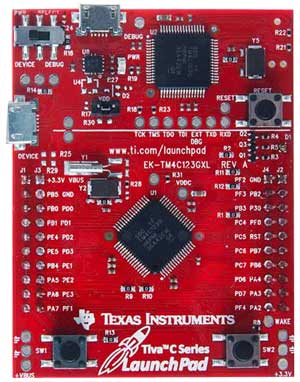This example implements the Dining Philosophers Problem sample application on the EK-TM4C123GLX board (ARM Cortex-M4F).

EK-TM4C123GXL board
The DPP example is located in the directory qpcpp/examples/arm-cm/dpp_ek-tm4c123gxl, which is organized as follows:
qpcpp/
+-examples/
| +-arm-cm/
| | +-dpp_ek-tm4c123gxl/
| | | +-lint/
| | | | +-lin.bat
| | | | +-options.lnt
| | | +-qk/
| | | | +-arm/
| | | | | +-dpp-qk.uvprojx
| | | | +-gnu/
| | | | | +-Makefile
| | | | +-iar/
| | | | | +-dpp-qk.eww
| | | | +-ti/
| | | | | +-.ccsproject
| | | | | +-.cproject
| | | | | +-.project
| | | | +-bsp.cpp
| | | | +-main.cpp
| | | +-qv/
| | | | +-arm/
| | | | | +-dpp-qk.uvprojx
| | | | +-gnu/
| | | | | +-Makefile
| | | | +-iar/
| | | | | +-blinky-qk.eww
| | | | +-bsp.cpp
| | | | +-main.cpp
| | | +-qxk/
| | | | +-arm/
| | | | | +-dpp-qk.uvprojx
| | | | +-gnu/
| | | | | +-Makefile
| | | | +-iar/
| | | | | +-dpp-qk.eww
| | | | +-ti/
| | | | | +-.ccsproject
| | | | | +-.cproject
| | | | | +-.project
| | | | +-bsp.cpp
| | | | +-main.cpp
| | | | +-test.cpp
| | | +-qspyview/
| | | | +-dpp.tcl
| | | | +-qspyview.bat
Features Demonstrated
- cooperative QV kernel
- with ARM-KEIL toolchain
- with GNU-ARM toolchain
- with IAR-ARM toolchain
- with TI-ARM toolchain (CCS)
- preemptive run-to-completion QK kernel
- with ARM-KEIL toolchain
- with GNU-ARM toolchain
- with IAR-ARM toolchain
- with TI-ARM toolchain (CCS)
- preemptive dual-mode QXK kernel
- with ARM-KEIL toolchain
- with GNU-ARM toolchain
- with IAR-ARM toolchain
- with TI-ARM toolchain (CCS)
- QP/Spy software tracing (output)
- QP/Spy software tracing (input QS-RX)
- Unit Testing with QUTest
- Windows emulation with GUI (multithreaded)
- Windows emulation with GUI (single threaded, win32-qv)
Running the Example
Once programmed into the board, the example rapidly toggles the Blue LED from the idle loop (blue LED glows) and toggles the Red and Green LEDs as the Philosophers change their state. Additionally, you can depress and hold the SW1 button (left) to PAUSE the application (Table transitions into the "paused" state). Releasing the SW1 button causes transition back to the "serving" state.
Unit Testing
The examples demonstrates the QUTest unit tests for the application.
QP/Spy Software Tracing
The application also demonstrates QP/Spy software tracing output and input. To exercise this feature, you need to build and upload the Spy build configuration into the board.
